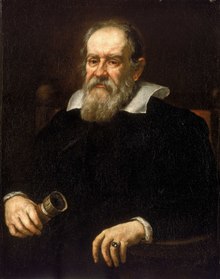
Back Galileo Galilei Afrikaans Galileo Galilei ALS ጋሊልዮ Amharic Galileo Galilei AN गैलिलियो गैलिली ANP غاليليو غاليلي Arabic ڭاليليو ڭاليلي ARY جاليليو جاليلى ARZ গেলিলিঅ’ গেলিলি Assamese Galileo Galilei AST
Galileo Galilei | |
|---|---|
 Portrait c. 1640 | |
| Born | Galileo di Vincenzo Bonaiuti de' Galilei[1] 15 February 1564[2] Pisa, Duchy of Florence |
| Died | 8 January 1642 (aged 77) Arcetri, Grand Duchy of Tuscany |
| Education | University of Pisa |
| Known for | List
|
| Scientific career | |
| Fields | |
| Institutions | |
| Patrons | |
| Academic advisors | Ostilio Ricci da Fermo |
| Notable students | |
| Signature | |
 | |
| Part of a series on |
| Physical cosmology |
|---|
 |
Galileo di Vincenzo Bonaiuti de' Galilei (15 February 1564 – 8 January 1642), commonly referred to as Galileo Galilei (/ˌɡælɪˈleɪoʊ ˌɡælɪˈleɪ/, US also /ˌɡælɪˈliːoʊ -/; Italian: [ɡaliˈlɛːo ɡaliˈlɛːi]) or mononymously as Galileo, was an Italian (Florentine)[a] astronomer, physicist and engineer, sometimes described as a polymath. He was born in the city of Pisa, then part of the Duchy of Florence and present-day Italy.[4] Galileo has been called the father of observational astronomy,[5] modern-era classical physics,[6] the scientific method,[7] and modern science.[8]
Galileo studied speed and velocity, gravity and free fall, the principle of relativity, inertia, projectile motion and also worked in applied science and technology, describing the properties of the pendulum and "hydrostatic balances". He was one of the earliest Renaissance developers of the thermoscope[9] and the inventor of various military compasses. With an improved telescope he built, he observed the stars of the Milky Way, the phases of Venus, the four largest satellites of Jupiter, Saturn's rings, lunar craters and sunspots. He also built an early microscope.
Galileo's championing of Copernican heliocentrism was met with opposition from within the Catholic Church and from some astronomers. The matter was investigated by the Roman Inquisition in 1615, which concluded that his opinions contradicted accepted Biblical interpretations.[10][11][12]
Galileo later defended his views in Dialogue Concerning the Two Chief World Systems (1632), which appeared to attack Pope Urban VIII and thus alienated both the Pope and the Jesuits, who had both supported Galileo up until this point.[10] He was tried by the Inquisition, found "vehemently suspect of heresy", and forced to recant. He spent the rest of his life under house arrest.[13][14] During this time, he wrote Two New Sciences (1638), primarily concerning kinematics and the strength of materials.[15]
- ^ Science: The Definitive Visual Guide. DK Publishing. 2009. p. 83. ISBN 978-0-7566-6490-9.
- ^ Drake 1978, p. 1.
- ^ Pliny the Elder, Letters 9.23.
- ^ Modinos, A. (2013). From Aristotle to Schrödinger: The Curiosity of Physics, Undergraduate Lecture Notes in Physics (illustrated ed.). Springer Science & Business Media. p. 43. ISBN 978-3-319-00750-2.
- ^ Singer, C. (1941). A Short History of Science to the Nineteenth Century. Clarendon Press. p. 217.
- ^ Whitehouse, D. (2009). Renaissance Genius: Galileo Galilei & His Legacy to Modern Science. Sterling Publishing. p. 219. ISBN 978-1-4027-6977-1.
- ^ Thomas Hobbes: Critical Assessments, Volume 1. Preston King. 1993. p. 59
- ^ Disraeli, I. (1835). Curiosities of Literature. W. Pearson & Company. p. 371.
- ^ Valleriani, Matteo (2010). Galileo Engineer. Dordrecht Heidelberg; London; New York: Springer. p. 160. ISBN 978-90-481-8644-0.
- ^ a b Hannam 2009, pp. 329–344.
- ^ Sharratt 1994, pp. 127–131.
- ^ Finocchiaro 2010, p. 74.
- ^ Finocchiaro 1997, p. 47.
- ^ Hilliam 2005, p. 96.
- ^ Carney, J. E. (2000). Renaissance and Reformation, 1500–1620.[page needed]
Cite error: There are <ref group=lower-alpha> tags or {{efn}} templates on this page, but the references will not show without a {{reflist|group=lower-alpha}} template or {{notelist}} template (see the help page).